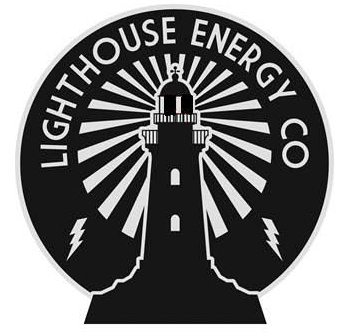Why Emergency Power Restoration Matters to Every Homeowner
Emergency power restoration is the process of safely restoring electricity after an outage. Utilities first assess damage, then prioritize repairs to critical facilities like hospitals before restoring main lines and, finally, individual homes.
The average U.S. customer faces about six hours of power interruptions annually, according to the U.S. Energy Information Administration, often due to severe weather. When the lights go out, it’s more than an inconvenience. Food spoils in as little as four hours, HVAC systems fail, and medical equipment can lose power, making the situation critical. Understanding how power is restored—and how to prepare—is essential for every homeowner.
I’m Bruce Kemp, an electrical contractor with decades of experience in emergency power restoration. My company has helped countless homeowners and businesses safely steer outages, from generator installation to post-restoration electrical checks.
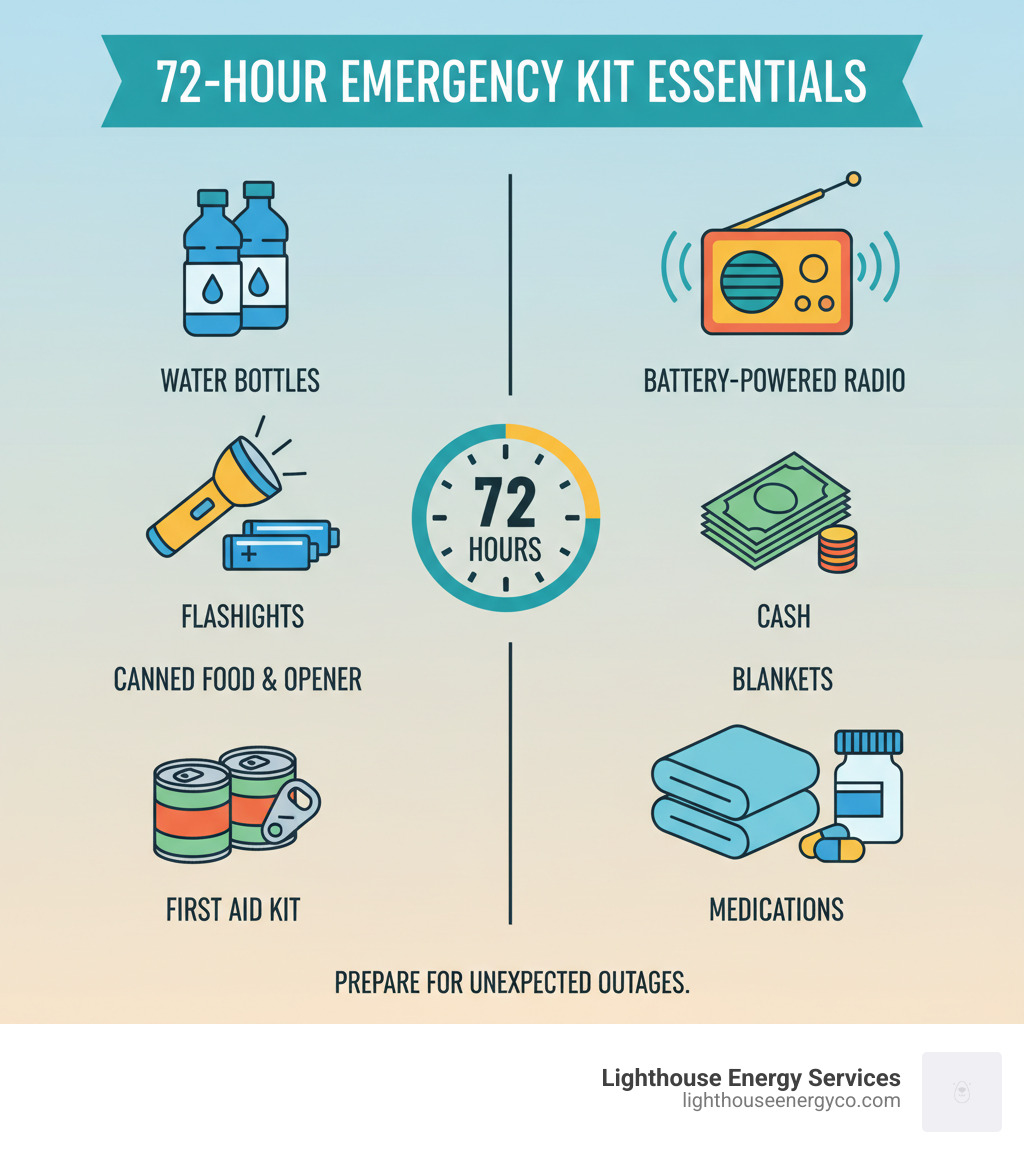
Before the Blackout: A Proactive Preparation Guide
The best time to prepare for emergency power restoration is before you need it. A little preparation can turn a potential crisis into a manageable inconvenience.
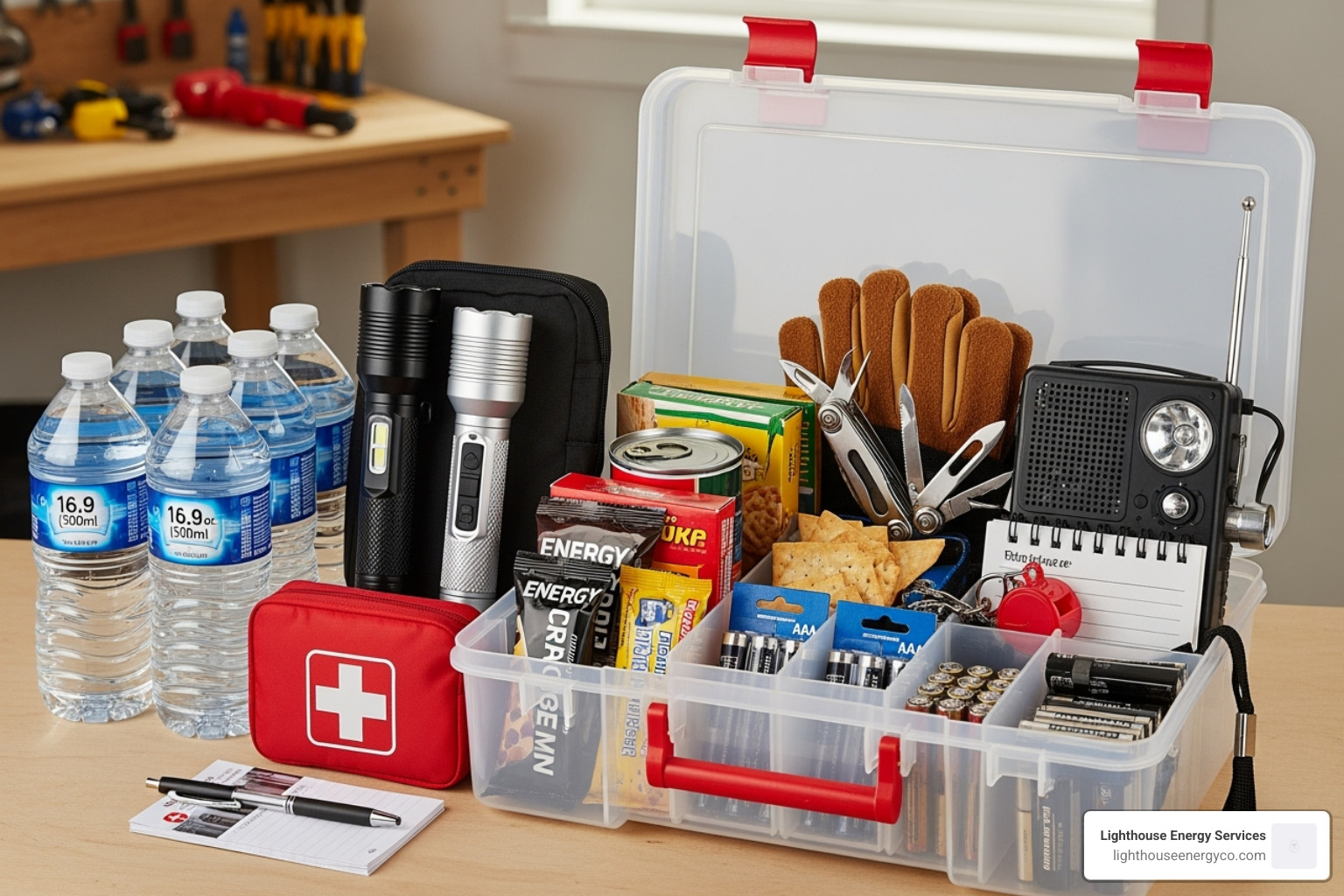
Building Your Emergency Preparedness Kit
Your emergency kit should contain enough supplies for 72 hours.
- Water: Your top priority. Store at least 2 liters per person per day.
- Food: Stock non-perishable items like canned goods, dried fruit, and energy bars. Don’t forget a manual can opener.
- Light and Information: Keep several flashlights with extra batteries (or wind-up/solar versions) and a battery-powered or wind-up radio for updates.
- Safety and Health: Include a first-aid kit, essential medications, and personal hygiene items.
- Other Essentials: Have cash on hand, as ATMs won’t work. Keep blankets for warmth and a paper list of emergency numbers. Customize the kit for infants, older adults, and pets.
Preparing Your Home and Family
Beyond the kit, a few home preparations are key.
- Surge Protectors: Use quality surge protectors to shield electronics from voltage spikes when power returns. For total protection, consider a whole-home surge protector. Our team can help; learn more about our electrical services.
- Emergency Plan: Create and practice a household emergency plan. Decide on a meeting place, communication methods, and who is responsible for the kit.
- Medical Needs: If anyone relies on medical devices or refrigerated medications, consult their doctor about outage protocols. For life-support equipment, a professionally installed backup power source like a generator is critical. We specialize in these installations.
- EVs and Garage Doors: Electric vehicle owners should keep their cars charged before a storm. Also, learn how to manually open your garage door in case you need to evacuate.
- Stay Informed: Monitor local news and weather reports for updates before a storm hits.
Navigating the Dark: What to Do During a Power Outage
When the lights go out, stay calm. Knowing the right steps will keep your family safe while you wait for emergency power restoration.
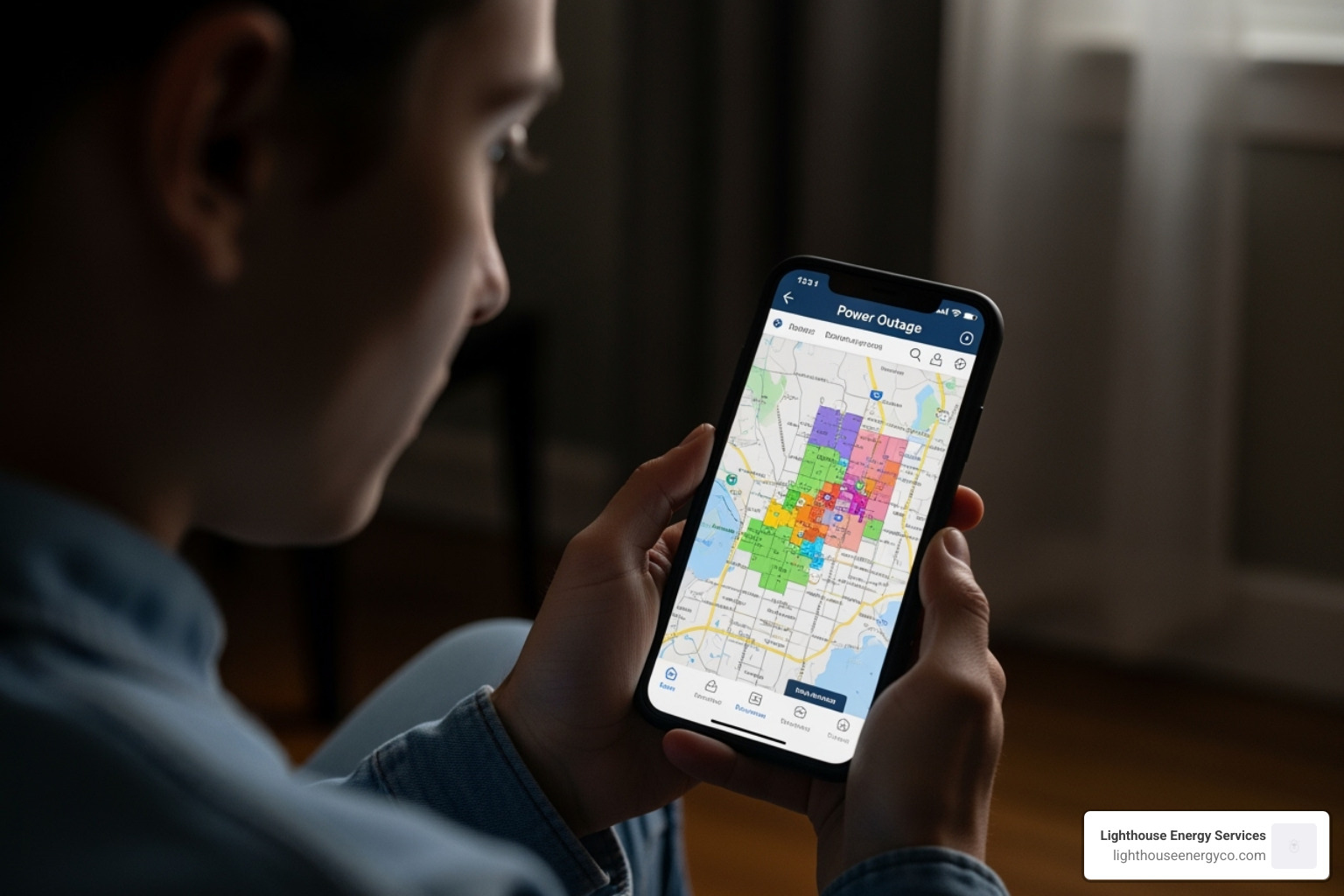
Immediate Actions for Safety and Food Preservation
First, check your circuit breakers. If they are fine, check if your neighbors have power. If not, it’s a wider outage.
- Unplug sensitive electronics like computers and TVs to protect them from a power surge upon restoration. Leave one light on to know when power returns.
- Keep refrigerator and freezer doors closed. A fridge stays cold for about 4 hours; a full freezer for 24-48 hours.
- Use flashlights, not candles, to prevent fire risk.
- Conserve your phone’s battery for essential communication and checking outage updates. A portable charger is invaluable.
For real-time updates in your area, Check FPL’s Power Tracker Map.
How to Prevent Carbon Monoxide (CO) Poisoning
Carbon monoxide is an invisible, odorless, and deadly gas produced by fuel-burning equipment.
- Install CO detectors with battery backup on every level of your home and test them monthly.
- Never use fuel-burning equipment indoors. This includes generators, charcoal grills, and propane heaters. Do not use them in a garage, even with the door open.
- Place portable generators at least 20 feet away from your home, with the exhaust pointing away from all windows and doors.
- Know the symptoms of CO poisoning: headache, dizziness, nausea, and confusion. If your CO alarm sounds or someone shows symptoms, evacuate immediately and call 911.
Reporting an Outage and Staying Informed
Report your outage to your utility company via their phone line, website, or app. For local residents, you can report a power concern to FPL.
Use your battery-powered radio for news and weather updates, especially if cell service is down or your phone battery is low. Download your utility’s mobile app before a storm for outage maps and notifications.
While we can’t restore neighborhood power, Lighthouse Energy Services is available 24/7 for electrical issues within your home once power is back.
How Utilities Handle Emergency Power Restoration
Behind the scenes of a blackout, utility companies follow a structured plan for emergency power restoration. Understanding this process helps set realistic expectations.
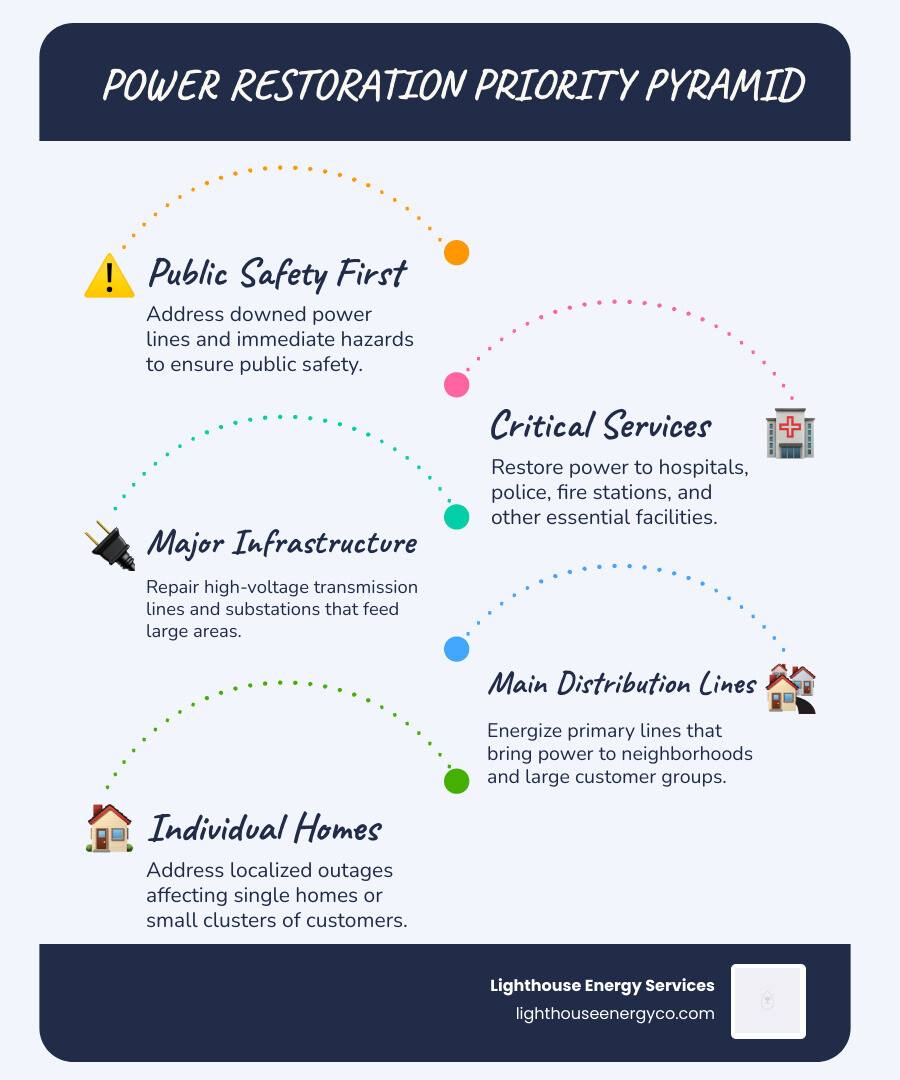
How Utility Companies Prioritize Repairs
Utilities restore power in a specific order to ensure public safety and help the most people quickly.
- Public Safety: The first step is always securing hazards like downed power lines.
- Critical Facilities: Next are hospitals, police and fire stations, and water treatment plants.
- Transmission & Substations: Repairing these “highways” of the grid restores power to thousands at once.
- Main Distribution Lines: These lines serve entire neighborhoods and are repaired next.
- Individual Homes: The final step addresses service lines to individual homes and businesses.
You can Learn about FPL’s restoration priorities on their website.
The Typical Emergency Power Restoration Process
The process is a multi-stage operation:
- Damage Assessment: As soon as it’s safe, crews survey the area on foot or with drones and helicopters to identify damage.
- Crew Mobilization: Local crews are activated, and mutual aid agreements bring in lineworkers from other utilities.
- Infrastructure Repair: Crews repair the backbone of the grid—power plants, transmission lines, and substations.
- Large-Scale Restoration: Attention then shifts to main distribution lines to restore power to the largest number of customers.
- Isolated Outages: Finally, crews fix problems affecting single homes, which may require a licensed electrician if the issue is on your property.
Factors Influencing Emergency Power Restoration Times
Several factors affect how long an outage lasts:
- Severity of Damage: Widespread damage from a hurricane takes much longer to repair than a localized equipment failure.
- Accessibility: Flooding, debris, and blocked roads can prevent crews from reaching damaged equipment.
- Number of Outages: A high volume of outages can overwhelm available crews, even with outside help.
- Crew Safety: Work stops during unsafe conditions like high winds or lightning.
- Complexity of Repairs: Replacing a fuse is quick; rebuilding a transmission line can take days.
The U.S. average power interruption duration is about six hours, but severe weather can extend this to days or weeks.
Powering Through: A Guide to Safe Generator Use
A generator can be a lifesaver during an outage, but improper use can be deadly due to carbon monoxide poisoning or electrical accidents. Using these powerful tools safely is non-negotiable.
Operating a Portable Generator Safely
The most important rule is to always run a generator outdoors, far from your home.
- Follow the 20-foot rule: Place the generator at least 20 feet away from your house, garage, and any other building to prevent deadly carbon monoxide fumes from seeping inside.
- Point the exhaust away from all windows, doors, and vents.
- Never run a generator in a garage or shed, even with the door open.
- Turn the generator off and let it cool before refueling to prevent fires.
- Use heavy-duty, outdoor-rated extension cords and inspect them for damage before use.
Connecting a Generator to Your Home’s Electrical System
Never plug a generator directly into a wall outlet. This creates a deadly hazard called backfeeding, where electricity flows back to utility lines, endangering utility workers. It can also destroy your generator and cause fires.
The only safe way to connect a generator to your home is with a professionally installed transfer switch or an interlock kit.
- A transfer switch completely isolates your home from the utility grid before engaging the generator, ensuring only one power source is active at a time.
- An interlock kit is a mechanical device on your breaker panel that prevents the main breaker and generator breaker from being on simultaneously.
Both devices must be installed by a licensed, qualified electrician. This is not a DIY project. Proper installation is critical for the safety of your family and utility crews. Emergency power restoration preparation includes a safe generator setup. Don’t risk it—Contact us for a safe generator setup and get professional peace of mind.
When the Power Comes Back On: Post-Restoration Safety
When the lights come back on, a few careful steps can protect your home’s electrical system. The emergency power restoration process isn’t over just yet.
Checking Your Home’s Electrical System
- Wait a few minutes for the electrical system to stabilize before turning anything on. This can prevent damage from initial power fluctuations.
- Reset circuit breakers correctly. If you turned them off, switch each breaker fully OFF before flipping it back ON. If a breaker trips again, it signals a problem. Watch a video on how to reset breakers for a visual guide.
- Reconnect appliances gradually. Plug in essentials like the refrigerator first, then add other devices one by one to avoid overloading your circuits.
- Check food for spoilage. Throw out any perishable food that has been above 40°F (4°C) for more than two hours to avoid foodborne illness.
When to Call a Professional for Post-Outage Problems
Some electrical issues require a professional. Call an electrician if you notice:
- Flickering or dimming lights, which can indicate loose connections or other serious problems.
- Burning odors from outlets or switches. This is a fire hazard. Turn off the circuit at the breaker panel and call for help immediately.
- Partial power to only some rooms or outlets.
- Visible damage to your outdoor electrical meter, service lines, or the mast connecting them to your home. Do not touch any damaged equipment.
Our licensed electricians are available 24/7 for emergency repairs in Palm Beach, Broward, and Miami-Dade counties. We answer our phones around the clock with qualified electricians, not an answering service. Learn more about our commitment on our About Us and our qualifications page.
Conclusion: Restoring Normalcy and Peace of Mind
Getting through a blackout safely isn’t luck—it’s about preparation, knowledge, and support. This guide has covered the key aspects of emergency power restoration, from building an emergency kit to understanding how utilities restore power. We’ve emphasized critical safety measures, like using generators correctly to prevent carbon monoxide poisoning and taking the right steps when power returns.
Proactive maintenance of your home’s electrical system, including professionally installed surge protectors and generator connections, can turn a crisis into an inconvenience. Power outages can also be emotionally draining; don’t hesitate to seek support from resources like Info-Social (811, option 2) if you’re feeling overwhelmed.
While the utility company restores neighborhood power, ensuring your home’s electrical system is safe is our job. A qualified electrician is essential for installing generator transfer switches or diagnosing post-outage issues like flickering lights.
At Lighthouse Energy Services, we are South Florida’s trusted 24/7 electrical partner for Palm Beach, Broward, and Miami-Dade counties. Our phones are answered around the clock by qualified electricians, not a service, so you get help when you need it. We promise prompt, professional service with no hidden fees—done right, and done right now.
When the power goes out, you’re not alone. We’re here to restore your electricity and your peace of mind.
